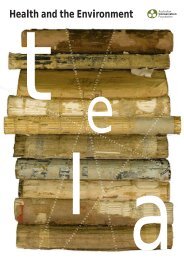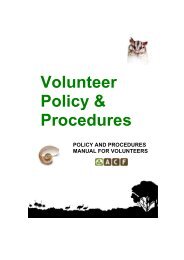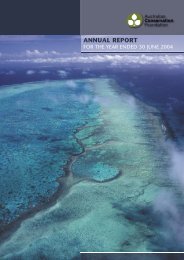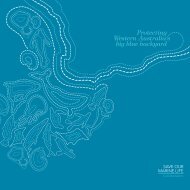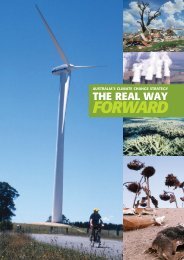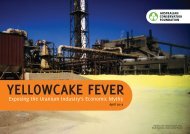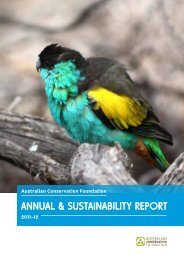Submission on Draft Water Sharing Plan for the Murrumbidgee River
Submission on Draft Water Sharing Plan for the Murrumbidgee River
Submission on Draft Water Sharing Plan for the Murrumbidgee River
You also want an ePaper? Increase the reach of your titles
YUMPU automatically turns print PDFs into web optimized ePapers that Google loves.
Inland <strong>River</strong>s Network and Nature C<strong>on</strong>servati<strong>on</strong> Council submissi<strong>on</strong>:<br />
<strong>Draft</strong> <strong>Water</strong> <strong>Sharing</strong> <strong>Plan</strong> <strong>for</strong> <strong>the</strong> <strong>Murrumbidgee</strong> Regulated <strong>River</strong> <strong>Water</strong> Source – 14 June 2002<br />
documents will be coming <strong>on</strong> line during <strong>the</strong> life of <strong>the</strong> WSP. These recovery plans may identify <strong>the</strong><br />
requirement <strong>for</strong> additi<strong>on</strong>al water in order to facilitate <strong>the</strong> recovery of <strong>the</strong>se species, and this plan must be able<br />
to provide <strong>for</strong> such requirements.<br />
There is not sufficient reference to <strong>the</strong>se species, key threatening processes, threat abatement plans and<br />
recovery plans in Part B of <strong>the</strong> WSP. This is c<strong>on</strong>cerning, because this is <strong>the</strong> <strong>on</strong>ly part of <strong>the</strong> plan that is<br />
statutory.<br />
Recommendati<strong>on</strong>s<br />
IRN, NCC and ACF recommend that:<br />
• The threatened species identified in <strong>the</strong> WSP Guide be listed as Schedule 9 of <strong>the</strong> <strong>Water</strong> <strong>Sharing</strong> <strong>Plan</strong> <strong>for</strong><br />
<strong>the</strong> <strong>Murrumbidgee</strong> Regulated <strong>River</strong> <strong>Water</strong> Source.<br />
• Provisi<strong>on</strong> should be made within <strong>the</strong> WSP <strong>for</strong> additi<strong>on</strong>al water, as identified by a Threatened Species<br />
Recovery <strong>Plan</strong>, to be made available without <strong>the</strong> requirement to pay compensati<strong>on</strong> to water extractors.<br />
• Minimum flow sharing should at <strong>the</strong> very least provide <strong>for</strong> passage of native fish over riffles, and past<br />
instream obstructi<strong>on</strong>s such as weirs or road crossings, particularly during breeding times.<br />
• Part B of <strong>the</strong> WSP acknowledges <strong>the</strong> relevant recovery plans and facilitates relevant implementati<strong>on</strong> of<br />
threat abatement plans and recovery plans where threatened species, populati<strong>on</strong>s and communities occur.<br />
Flow arrangements should be c<strong>on</strong>sistent with threat abatement plans and recovery plans.<br />
• Part B of <strong>the</strong> WSP acknowledges Key Threatening Processes (KTPs) and reduce or ameliorate <strong>the</strong><br />
impacts of KTPs wherever possible. Given <strong>the</strong> importance of threatened species recovery, this should<br />
exclude any potential <strong>for</strong> compensati<strong>on</strong> to water users.<br />
• Threatened species c<strong>on</strong>siderati<strong>on</strong>s should be incorporated in Part 14 Per<strong>for</strong>mance Indicators, as part of <strong>the</strong><br />
species presence and absence indicators.<br />
<strong>Water</strong> Quality<br />
IRN, NCC and ACF are c<strong>on</strong>cerned that no menti<strong>on</strong> is made about water quality, <strong>the</strong> m<strong>on</strong>itoring regime that<br />
will be carried out and <strong>the</strong> standards that will be applied in <strong>the</strong> m<strong>on</strong>itoring program. IRN, NCC and ACF<br />
believe that water quality m<strong>on</strong>itoring should be c<strong>on</strong>sistent with ANZECC guideline ‘trigger values’ as<br />
outlined in <strong>the</strong> SWMOP.<br />
Recommendati<strong>on</strong>s<br />
IRN, NCC and ACF recommend that:<br />
• <strong>Water</strong> quality should be m<strong>on</strong>itored in accordance with ANZECC guidelines.<br />
M<strong>on</strong>itoring<br />
The <strong>Water</strong> Management Act 2000 provides <strong>for</strong> review of a WSP within <strong>the</strong> fifth year of its tenure so as to<br />
ascertain whe<strong>the</strong>r it remains ‘adequate and appropriate’ <strong>for</strong> implementing <strong>the</strong> <strong>Water</strong> Management Principles<br />
of <strong>the</strong> Act. In additi<strong>on</strong> <strong>the</strong> Act provides <strong>for</strong> auditing of plans.<br />
The Integrated M<strong>on</strong>itoring of Envir<strong>on</strong>mental Flows (IMEF) inter-agency m<strong>on</strong>itoring program commenced in<br />
1998, with <strong>the</strong> first stage due <strong>for</strong> completi<strong>on</strong> in 2003. IMEF data reported thus far has provided a useful<br />
basis <strong>for</strong> critically appraising <strong>the</strong> effectiveness and adequacy of current envir<strong>on</strong>mental flow rules. If <strong>the</strong><br />
IMEF is to guide <strong>the</strong> delivery of envir<strong>on</strong>mental flows <strong>the</strong>re must be sufficient flexibility within <strong>the</strong> ten-year<br />
tenure of <strong>the</strong> WSP. This could be most usefully achieved with a provisi<strong>on</strong> exempting Government <strong>for</strong><br />
compensating water users <strong>for</strong> reduced allocati<strong>on</strong>s if <strong>the</strong> m<strong>on</strong>itoring results clearly indicate a need to increase<br />
envir<strong>on</strong>mental allocati<strong>on</strong>s.<br />
- 11 -



